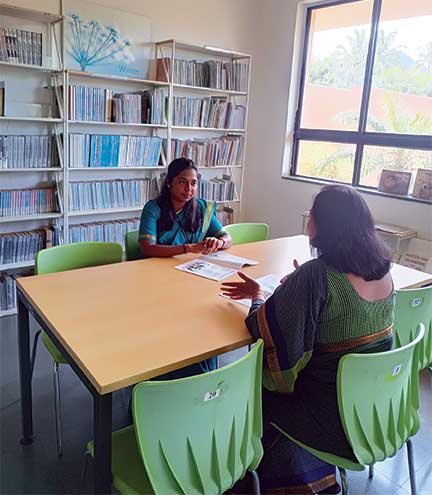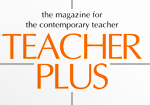B. Ajitha
Having entered the teaching profession as a novice without any ‘field experience’, it took the wind out of my sails when I had to face a motley group of students on my maiden teaching assignment. Nothing had prepared me to tackle the everyday emergencies and innumerable challenges that came up. Good intent and romantic notions alone weren’t enough to tide over the crises that presented themselves from day one of my very first teaching assignment.
Fast forward to the present … almost two decades later, I am still grappling with the universal issues of plummeting levels of student motivation, yawning gaps in learning, and not-so-impressive learning outcomes – an eerie feeling that not much has changed in the intervening years. But what has changed is the support system I have managed to put in place to address the common issues that plague the teaching fraternity. Look no further than the colleague sitting next to you in the staffroom to embark on your journey towards becoming a better teacher!
I have been really fortunate to have had the opportunity to work and learn from like-minded people over the years. It all began in 2011 when I teamed up with a colleague from the same department to do collaborative action research on reflective teaching. This pet project marked the beginning of a journey towards continuous professional development by providing the right impetus and framework required to look objectively at teaching practices, collaborate with peers for real-time feedback,and design interventions to address the most pressing issues in the classroom.

The collaborative nature of work infused so much energy and enthusiasm into researching and digging into our own repertoire of classroom experiences that the process in itself was edifying and enabling. The process of reflecting on our classroom practices, reading relevant literature on effective pedagogical practices, and comparing notes on best practices provided the right stimulus needed for critical inquiry into the effectiveness of the teaching-learning process. The enriching learning experience gained in the process of taking up the collaborative action research instilled in me the quality of being open to opportunities for professional growth through a willingness to admit to shortcomings and work towards incorporating strategies and techniques to make learning stimulating and rewarding for my students. Thanks to this invaluable learning experience, today I am a reflective teaching practitioner who appreciates the value of documenting real classroom experiences in order to look back at them as objectively and critically as possible and learn from them.
Another invaluable opportunity to learn from peers presented itself in 2016 when a new teacher joined the school and I had the privilege of learning by observing his teaching style and practical insights into classroom management and lesson planning. When many teachers handling a particular class famous for its mischievous students were at their wit’s end, this gentleman managed the same class so smoothly and also had the students completely engaged from beginning to the end with such elan and aplomb that I had to know how the magic worked! I requested to sit in his class and observe his teaching style. Many discussions and deliberations later, I was better schooled on the significance of classroom rules, routines and procedures for effective classroom management. It was a mini-crash course on carefully designing a learning experience by curating elements that would make the class interesting and keep the students engaged and invested in learning. No teacher training programme could have taught me so much in practical terms.
The pandemic presented another opportunity for peer learning. The sudden and abrupt way in which teachers across the globe were forced to adapt to virtual teaching, though daunting at first, made for another great collaboration among teachers. Only this time, the scurry was for digital literacy. The desperate need to engage students online and the frustration born out of the disconnect on the virtual platform compelled teachers to learn ways of creating a semblance of normality through the use of digital tools. It was a period of exposure to best practices in teaching through multiple pathways of learning thanks to the educators guiding fellow teachers through bite-sized tutorials to help navigate the uncharted territory of virtual teaching.
It is one thing to actively look for pathways to professional development and a completely different thing to take responsibility to create an organizational culture for continuous professional development among teachers. One of my most successful strategies as a teacher trainer has been organizing an in-house teacher training programme at DPS Coimbatore for in-service teachers using a very powerful strategy for collaborative learning called Jigsaw.
Having found that the instructor-led training sessions often delivered in the lecture method were not effective in engaging the teachers all through the session, I started looking for ways to address the problem of attention deficit and disengagement among teachers. I was also looking at ways of infusing enthusiasm in teachers towards learning and encouraging openness to highly effective and result-oriented teaching strategies. The objective is to create a culture of learning through vibrant discussions and deliberations on educational practices for better learning outcomes for students and thus encourage teachers to apply the insights gained from the training in everyday classroom instruction and lesson planning. This strategy of collaborative learning used in weekly training programmes has been found to be effective in fostering a conducive learning environment for teachers to share insights on the learning modules based on their own classroom experiences thus creating a culture of sharing best practices through peer learning. Learning is made joyful through the opportunity to have an immersive learning experience during stimulating interactions among teachers, thus motivating them to experiment with the pedagogical ideas in actual classroom scenarios rather than just retaining the theoretical knowledge in their teaching repertoire.
Teaching is a profession that has at its core meaningful interaction, scintillating conversations, and a passion for learning – be it among teachers and students or among students themselves or teachers working in collaboration. As teachers are instrumental in putting their students on the path to self-discovery, it is equally important that they continuously work together in tandem towards the common objective of ensuring good learning for all.
The author teaches English and Life Skills to students of secondary and senior secondary classes at Delhi Public School, Coimbatore. She also designs, coordinates and oversees the in-service training programme at Delhi Public Schools in Patna, Pune, Ludhiana and Coimbatore under the aegis of Takshila Educational Society. She can be reached at ajithabashkar@gmail.com.
